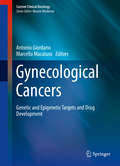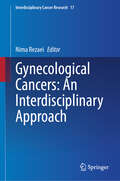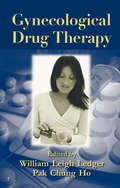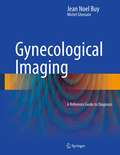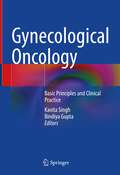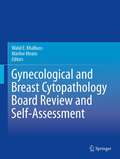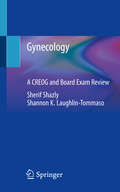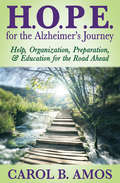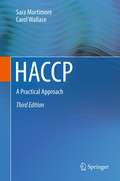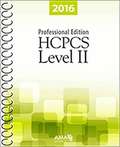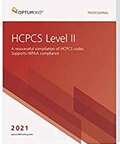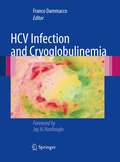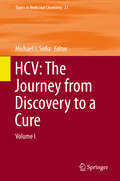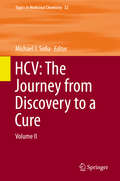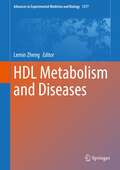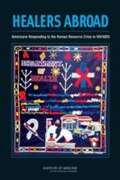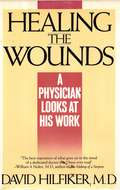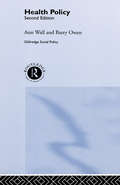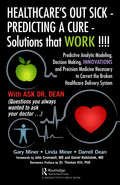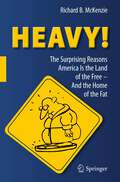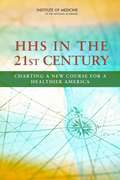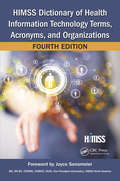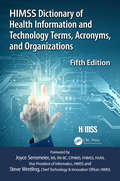- Table View
- List View
Gynecological Cancers
by Antonio Giordano Marcella MacalusoFacilitating the collaboration between the basic, translational, and clinical sciences, this book provides an overview of the genetic and epigenetic mechanisms underlying the formation and progression of gynecological cancers. Gynecological Cancers: Genetic and Epigenetic Targets and Drug Development gathers all of the molecular and cellular aspects of gynecological cancer together within one volume, providing detailed and up-to-date information on the etiology, diagnosis, and treatment of gynecological cancers. Gynecological Cancers: Genetic and Epigenetic Targets and Drug Development also discusses the racial and ethnic disparities in the treatment of gynecological cancers through cost effective modalities like single visit screening and diagnosis, well women clinics, and mobile clinics. Written and edited by leaders in the field, this volume within the Current Clinical Oncology series is an indispensable resource for today's practicing oncologist.
Gynecological Cancers: An Interdisciplinary Approach (Interdisciplinary Cancer Research #17)
by Nima RezaeiThe “Gynecological Cancers: An Interdisciplinary Approach” is the seventeenth volume of the “Interdisciplinary Cancer Research” series, publishes comprehensive volume on diagnosis and treatment of gynecological cancers. The volume starts with a general chapter on polycystic ovarian syndrome and increased risk of female cancers. Cervical cancer natural history, diagnosis, and management as well as the roles of infiltrated immune cells in the tumor microenvironment and metabolomic profiling as a promising tool for the noninvasive detection of endometrial cancer are discussed in this volume. An update on diagnosis and treatment of ovarian cancers is also fully discussed. This is the main concept of Cancer Immunology Project (CIP), which is a part of Universal Scientific Education and Research Network (USERN). This interdisciplinary book will be of special value for gynecologists and oncologists who wish to have an update on diagnosis and treatment of gynecological cancers.
Gynecological Drug Therapy
by Pak Chung Ho William Leigh LedgerThe most comprehensive and current review available on the wide spectrum of pharmaceuticals used in gynecology and reproductive medicine, this manual provides all-encompassing chapters on specific drugs used in the management of gynecologic oncology and infection, pregnancy, menstrual dysfunction, menopause, and infertility-listing the licensed and
Gynecological Imaging: A Reference Guide to Diagnosis
by Jean Noel Buy Michel GhossainThis book provides a detailed guide to the use and interpretation of color Doppler ultrasound, CT, and MR imaging in patients with gynecological disorders. The advantages and limitations of each modality in imaging different pathologies are clearly presented, and advice is provided on the most appropriate option when ultrasound does not permit a definite diagnosis or fails to determine the precise extension of a lesion. Throughout, emphasis is placed on the importance of microscopic and macroscopic findings for a full understanding of the radiological appearances, and relevant points from the basic sciences are also highlighted. Special attention is paid to issues of differential diagnosis and imaging results that are characteristic of a particular type of lesion. The authors are recognized experts in the field who draw upon their considerable experience to provide an up-to-date reference book highly relevant to everyday clinical practice.
Gynecological Oncology: Basic Principles and Clinical Practice
by Bindiya Gupta Kavita Singh'This book, Gynecological Oncology-Basic Principles and Clinical Practice, is a detailed resource. It gives relevant principles to help successfully utilize the latest diagnostic methodologies and management strategies in all aspects of gynecologic oncology. It deals with practical tips and evidence on core topics such as surgical practices, chemotherapy, radiation and palliative care in oncology which help with skill enhancement and improve understanding. Besides, laying the foundation for management of clinical gynecological oncology, it promotes lateral thinking, a holistic approach and is useful in daily practice as a go-to for practitioners and academics with teaching commitments.
Gynecological and Breast Cytopathology Board Review and Self-Assessment
by Walid E. Khalbuss Marilee MeansGynecological and Breast Cytopathology Board Review and Self-Assessment is a comprehensive systems-based review of gynecological and breast cytology including cytomorphology, pitfalls and ancillary studies. Presented in a high-yield format with board-type multiple choice questions and detailed answers, this review includes chapters covering Pap smear cytology, colposcopy, breast FNA, and Pelvic washings. The book is also enriched with features to maximize studying and reviewing of cytopathology, including high-yield review with tables emphasizing key points, board exam-type questions, and high quality full-color images. Written by cytologists and cytopathologists with experience in the practice of modern cytology, as well as intensive teaching experience at national and international levels. Gynecological and Breast Cytopathology Board Review and Self-Assessment provides an excellent review, resource, and self-assessment for pathologists, cytopathologists, cytotechnologists, and trainees preparing for board examinations.
Gynecology: A CREOG and Board Exam Review
by Sherif Shazly Shannon K. Laughlin-TommasoThis book is a thorough and easy-to-use guide to gynecology for residents preparing for their CREOG and board examinations. Books available for gynecology residents are generally either clinically directed or academically based. The books in the first group are usually brief, suitable as handbooks for residents to use during daily practice. These books, however, do not provide adequate background information to prepare for CREOG or ABOG board examinations. The more academically-focused books provide detailed background, but do not offer simple and quick assistance during daily practice or studying. This book aims to provide the most beneficial parts of both products.Throughout, the material is simplified and well-organized to provide an excellent resource for clinical practice, with ample use of bullets and key points. The content is also comprehensive, providing the appropriate background knowledge and a systematic approach that makes it an excellent source for the board examination. Topics are divided into four sections: general gynecology, urogynecology, reproductive endocrinology and infertility, and gynecology oncology. Chapters then cover all major topics in each area, including uterine fibroids, polycystic ovary syndrome, and genital infections. Each chapter additionally includes multiple choice questions for residents to test their knowledge of the material.This is an ideal guide for residents in OBGYN and practicing gynecologists looking for a refresher and quick reference.
Gynäkologie und Geburtshilfe
by Stephan SeitzDieses Buch bietet übersichtlich und leicht verständlich alle Prüfungsinhalte der Gynäkologie und Geburtshilfe. Angefangen wird bei den Grundlagen zu Anatomie, Physiologie und den Untersuchungsmethoden. Sowohl die Gynäkologie als auch die Geburtshilfe werden ausführlich erklärt und mit zahlreichen Abbildungen anschaulich gemacht. Ebenso wird auf die Humangenetische Beratung und die Dokumentation eingegangen.Für die optimale Vorbereitung auf die Prüfung helfen Ihnen: Fragen für die mündliche Prüfung am KapitelendeAlgorithmen für den schnellen ÜberblickFallbeispiele für den Aha-EffektÜbersichten zum schnellen LernenMerksätze für das WichtigsteZusammenfassungen am Kapitel- oder Abschnittsende Der Herausgeber: Priv-Doz. Dr. Stephan Seitz ist Facharzt für Frauenheilkunde und Geburtshilfe und stellvertretender Direktor der Klinik für Frauenheilkunde und Geburtshilfe der Universität Regensburg am Caritas-Krankenhaus St. Josef.
Gynäkologische Endokrinologie und Kinderwunschtherapie: Prinzipien und Praxis
by Michael Amrani Rudolf SeufertAllgemeinverständlich und kurzgefasst stellt dieses Buch die physiologischen Grundlagen der gynäkologischen Endokrinologie und Fortpflanzungsbiologie dar. Hierauf aufbauend werden die wichtigsten Krankheitsbilder und deren Pathophysiologie als auch Bedeutung für den unerfüllten Kinderwunsch dargelegt. Etablierte diagnostische und therapeutische Verfahren werden jeweils weitgehend vertieft und für den klinischen Gebrauch erläutert. Im Buch sind Kapitel zu unterschiedlichen Themenschwerpunkten zu finden:GrundlagenwissenEtablierte diagnostische Verfahren und gynäkologischen FertilitätsstörungenPraxisrelevante Aspekte männlicher Fruchtbarkeitsstörungen, Schilddrüsenerkrankungen im Rahmen des unerfüllten Kinderwunsches, Menopause und KontrazeptionMethoden und Facetten der Kinderwunschbehandlung, von perikonzeptioneller Beratung, natürlicher Familienplanung bis hin zu genetischen und psychologischen AspektenErläuterung von Risiken und VermeidungsstrategienRechtliche und ethische FragenQualitätssicherung in der Reproduktionsmedizin Ziel des Buchs ist die praktische Anwendung und kritische Auseinandersetzung mit den aktuellen Möglichkeiten der modernen Reproduktionsmedizin und gynäkologischen Endokrinologie. Es richtet sich an nicht spezialisierte Gynäkologen, Reproduktionsmediziner sowie Ärzten und Ärztinnen in der Weiterbildung.
H.O.P.E. for the Alzheimer's Journey: Help, Organization, Preparation, & Education for the Road Ahead
by Carol B. Amos&“A useful, step-by-step guide for anyone new to caring for those with Alzheimer&’s.&” —Library Journal H.O.P.E. for the Alzheimer&’s Journey equips Alzheimer&’s caregivers with knowledge, tools, and advice for their difficult road ahead. Author Carol B. Amos incorporates her own experience—including her family&’s email correspondence illustrating how they coped during this particular challenge. Amos also introduces The Caregiving Principle™: a simple approach that provides a deeper understanding of a person with Alzheimer&’s disease and a framework for the caregiver&’s role. She provides examples of how The Caregiving Principle™ helped her connect with her mother. H.O.P.E. for the Alzheimer&’s Journey encourages caregivers to take care for themselves and provides inspiration for a less stressful, more rewarding journey.
HACCP
by Carol Wallace Sara MortimoreHACCP: A Practical Approach, 3rd edition has been updated to include the current best practice and new developments in HACCP application since the last edition was published in 1998. This book is intended to be a compendium of up-to-date thinking and best practice approaches to the development, implementation, and maintenance of HACCP programs for food safety management. Introductory chapters set the scene and update the reader on developments on HACCP over the last 15 years. The preliminary stages of HACCP, including preparation and planning and system design, are covered first, followed by a consideration of food safety hazards and their control. Prerequisite program coverage has been significantly expanded in this new edition reflecting its development as a key support system for HACCP. The HACCP plan development and verification and maintenance chapters have also been substantially updated to reflect current practice and a new chapter on application within the food supply chain has been added. Appendices provide a new set of case studies of practical HACCP application plus two new case studies looking at lessons learned through food safety incident investigation. Pathogen profiles have also been updated by experts to provide an up-to-date summary of pathogen growth and survival characteristics that will be useful to HACCP teams. The book is written both for those who are developing HACCP systems for the first time and for those who need to update, refresh and strengthen their existing systems. New materials and new tools to assist the HACCP team have been provided and the current situation on issues that are still undergoing international debate, such as operational prerequisite programs. All tools such as decision trees and record-keeping formats are provided to be of assistance and are not obligatory to successful HACCP. Readers are guided to choose those that are relevant to their situations and which they find are helpful in their HACCP endeavors.
HCPCS Level II Professional Edition
by The Editors at the American Medical AssociationToday, medical coding is an intricate and immense process that is present in every health care setting. 2016 HCPCS Level II was developed to help meet the needs of today's coder.
HCPS Level II Professional
by Optum360Accurately report supplies and services for physician, hospital outpatient, and ASC settings with the 2021 HCPCS Level II Professional. Use this comprehensive reference for the HCPCS code set that focuses on management of reimbursement. This user-friendly book guides any coder confidently through current modifiers, code changes, additions, and deletions with information as dictated by the Centers for Medicare and Medicaid Services (CMS).
HCV Infection and Cryoglobulinemia
by Franco DammaccoThe first observation of cold-induced precipitation of serum proteins dates back to 1933, when Wintrobe and Buell first described an unusual case of multiple myeloma in a woman whose serum reversibly precipitated at cold temperatures. In 1947 Lerner and Watson showed cold-precipitable proteins to be gammaglobulins and called them 'cryoglobulins' and the corresponding clinical condition 'cryoglobulinemia'. Meltzer and Franklin in 1966 provided an accurate description of the typical clinical symptoms associated with cryoglobulinemia, showed that they consisted of two different globulin components and, because of the ignorance on its etiology, called this clinical condition 'essential mixed cryoglobulinemia'. For almost 20 years progress has been rather slow in this field, but when at the end of the '80s it finally became possible to detect the occurrence in the serum of antibodies to the hepatitis C virus (HCV), many groups in Europe and the United States almost simultaneously reported that a high proportion of 'essential' cryoglobulinemias are in fact associated with HCV infection. This hallmark has resulted in a new impetus and great enthusiasm in carrying out new researches made possible by the awareness that cryoglobulinemia is to be considered an undisputable extrahepatic manifestation of HCV infection. In addition, the evidence that HCV has tropism for hepatocytes and lymphocytes has stimulated new approaches to the autoimmune phenomena and the potential transformation in non-Hodgkin's lymphomas which not infrequently can be discovered in these patients. The same applies to the obvious therapeutic implications, once the association between HCV infection and mixed cryoglobulinemia has been firmly established. It was thus felt that times were ripe to produce a state-of-the-art survey of the multi-faceted picture of cryoglobulinemia. This book is indeed unique in the detail of its presentation, its completeness and its fundamental approach to the subject. The most qualified authors have been invited to contribute critical articles reviewing significant developments related to each of the eight sections in which the whole treatment has been divided: from basic mechanisms governing interactions between HCV and the immune system to the immunochemical characterization of cryoglobulins and the frequently concomitant serological abnormalities; from genetic features and the role of certain cytokines and chemokines to the cellular compartments of HCV infection and replication; from the clinical manifestations of cryoglobulinemic patients and their potential susceptibility to develop non-Hodgkin's lymphoma to conventional treatment of the syndrome and the newer, promising therapeutic advances. The reader will appreciate the immediacy of style, the striking illustrations, and the color plates. In addition, the comprehensive review of a systemic disease such as cryoglobulinemia will interest basic scientists and specialists involved in several disciplines, including internal medicine, hepatology, hematology, oncology, infectious diseases, rheumatology, nephrology and dermatology. General practitioners, graduate and post-graduate students will also find in this book an irreplaceable source of update in this fascinating field.
HCV: Volume I (Topics in Medicinal Chemistry #31)
by Michael J. SofiaHepatitis C is a liver disease caused by the hepatitis C virus (HCV) and infects approximately 75 million individuals worldwide. It is also one of the major causes of liver cancer and liver transplants. The elucidation of the HCV genome, and the development of a whole cell system to study the virus spurred the search for novel direct acting antiviral drugs to cure this disease. This global effort culminated in the development of direct acting antiviral drugs that led to cure rates approaching 100% in all patient populations after only 8-12 weeks of therapy. These efforts resulted in one of the greatest achievements in public health and provides the potential for eliminating HCV as a major disease worldwide.This volume is aimed at a broad audience of academic and industrial scientists interested in the discovery and development of drugs to treat viral diseases and those interested in reading about one of the most unique accomplishments in biomedical research. The volume will provide a one of a kind reference work that highlights the many efforts, from the discovery of the HCV virus, to the invention of breakthrough medicines and their use in the real world to cure patients. It is the companion book to the volume "HCV: The Journey from Discovery to a Cure - Volume II".
HCV: Volume II (Topics in Medicinal Chemistry #32)
by Michael J. SofiaHepatitis C is a liver disease caused by the hepatitis C virus (HCV) and infects approximately 75 million individuals worldwide. It is also one of the major causes of liver cancer and liver transplants. The elucidation of the HCV genome, and the development of a whole cell system to study the virus spurred the search for novel direct acting antiviral drugs to cure this disease. This global effort culminated in the development of direct acting antiviral drugs that led to cure rates approaching 100% in all patient populations after only 8-12 weeks of therapy. These efforts resulted in one of the greatest achievements in public health and provides the potential for eliminating HCV as a major disease worldwide.This volume is aimed at a broad audience of academic and industrial scientists interested in the discovery and development of drugs to treat viral diseases and those interested in reading about one of the most unique accomplishments in biomedical research. The volume will provide a one of a kind reference work that highlights the many efforts, from the discovery of the HCV virus, to the invention of breakthrough medicines and their use in the real world to cure patients. It is the companion book to the volume "HCV: The Journey from Discovery to a Cure - Volume I".
HDL Metabolism and Diseases (Advances in Experimental Medicine and Biology #1377)
by Lemin ZhengThis book focuses on both high-density lipoproteins (HDL) metabolism and related diseases from the perspectives of the world-class experts in HDL. Several chapters in this book provide the overall information about HDL metabolism via detailed discussion of HDL structures as well as several key molecules involved in its functions, such as SR-B1 and Cholesteryl Ester Transfer Protein Inhibitors and so on. The rest of this book illustrates the connection between HDL and several diseases that are the major concerns of people’s health in many countries, and devotes to exploring the therapies of HDL related diseases. With a better understanding of the HDL metabolism and diseases, this book will benefit the audiences with interest in HDL from biomedicine to clinical practice.
HEALERS ABROAD: Americans Responding to the Human Resource Crisis in HIV/AIDS
by Committee on the Options for Overseas Placement of U.S. Health ProfessionalsHealers Abroad: Americans Responding to the Human Resource Crisis in HIV/AIDS calls for the federal government to create and fund the United States Global Health Service (GHS) to mobilize the nation’s best health care professionals and other highly skilled experts to help combat HIV/AIDS in hard-hit African, Caribbean, and Southeast Asian countries. The dearth of qualified health care workers in many lowincome nations is often the biggest roadblock to mounting effective responses to public health needs. The proposal’s goal is to build the capacity of targeted countries to fight the HIV/AIDS pandemic over the long run. The GHS would be comprised of six multifaceted components. Full-time, salaried professionals would make up the organization’s pivotal “service corps,” working side-by-side with other colleagues already on the ground to provide medical care and drug therapy to affected populations while offering local counterparts training and assistance in clinical, technical, and managerial areas.
HEALING THE WOUNDS: A Physician Looks at His Work
by David HilfikerHealing the Wounds is the most revealing book ever written by a doctor about his own profession. In it, David Hilfiker breaks the code of silence surrounding the everyday practice of medicine and gives is a dramatically different personal account of how the family doctors gets by in a world of spiraling information and high anxiety. Drawing on his years of rural and urban experience, Dr. Hilfiker lets us all know what it really feels like to be a doctor. What do you do when you make a serious medical mistake? Is it enjoyable to play God? What do you say to a patient who wants reassurance when the essence of diagnosis is uncertainty? What about money? What happens when a patient is taking forever, your waiting room is full, and you want to get home? Dr. Hilfiker uses incidents from his own practice to examine many of the kinds of behavior for which doctors are criticized--aloofness, authoritarianism, lack of caring, and money. With compassion for doctor and patient alike, he shows how the stresses of medical practice lead to a climate of misunderstanding and hostility in which the goal of healing is the first casualty. Never before have we heard the voice of the doctor ever American is most likely to meet--the family doctor--telling the often painful truths of medical practice. A book for the medical community and the lay person alike, Healing the Wounds is a powerful exploration of what frustrates doctors (and infuriates patients) and what might be done about it).
HEALTH POLICY (The Gildredge Social Policy Series)
by Ann Wall Barry OwenThe health care system in Britain at the beginning of the twenty-first century is being subjected to radical rethinking. Health Policy examines how the NHS has developed to the point it has reached today as well as placing it in the wider context of the kinds of health care which are available to people in Britain.It looks at key issues which have arisen in the provision of health care such as rationing, the operation of interest groups, relationships between the public, voluntary and private sectors and whether the NHS has delivered care equally to all sectors of the population.In this second edition, the authors pay particular attention to the policy changes introduced by the Labour government following it selection in 1997 and places these within a wider discussion of the concept of a primary care-led system.Health Policy will be especially useful to readers who wish to inform themselves about what is happening in the NHS today or to deepen their understanding of current developments through an appreciation of how the health care system has evolved over the past fifty years. It includes useful summaries of key points, guides to further reading and a glossary of key terms.
HEALTHCARE's OUT SICK - PREDICTING A CURE - Solutions that WORK !!!!: Predictive Analytic Modeling, Decision Making, INNOVATIONS and Precision Medicine Necessary to Correct the Broken Healthcare Delivery System
by Linda Miner Gary D. Miner Darrell L. DeanThe U.S. healthcare system is in "complete chaos-disarray." Medical costs have increased significantly over the past 6 years with 70% increase for deductibles and 24% or more for health insurance premiums. All the while, workers earnings have either not increased or if they did, the pay raises were for less than the increase in the cost of medical care. The situation is unsustainable and the public wants the system fixed. This book offers ways of fixing the problems in healthcare. HEALTHCARE's OUT SICK - PREDICTING A CURE - Solutions that WORK !!!! first defines the "healthcare in crisis" problem. Through real patient experiences, the book describes the difficulties of getting through the maze of complexity among the plethora of "silo providers" which make up the industry. The heart of the book provides readers with a comprehensive solution that can work, a disruption that is necessary to provide Americans the medical care they need without the US public and healthcare providers and payors going into bankruptcy, insolvency or closure. This book delves into digitized medicine, payor and provider reimbursement models, and value-based healthcare delivery. It also includes a philosophy or mode of thinking and operation for the solutions that are needed for diagnosis-effective, cost-effective, and time-efficient healthcare delivery, of which digitized medicine, value-based care, and payor reimbursement modes are just some of the factors. The authors propose that the real solution involves having the patient at the center of the issues and changing from an archaic gold standard way of thinking to a "Predictive Analytic thinking" where one gets at the real truth by doing "real science" that in the end becomes effective not only for the population but for the individual person. This all leads to real person-centered and person-directed medicine and healthcare delivery.
HEAVY!
by Richard B. MckenzieAmerica's emerging "fat war" threatens to pit a shrinking population of trim Americans against an expanding population of heavy Americans in raging policy debates over "fat taxes" and "fat bans." These "fat policies" would be designed to constrain what people eat and drink - and theoretically crimp the growth in Americans' waistlines and in the country's healthcare costs. Richard McKenzie's HEAVY! The Surprising Reasons America Is the Land of the Free--And the Home of the Fat offers new insight into the economic causes and consequences of America's dramatic weight gain over the past half century. It also uncovers the follies of seeking to remedy the country's weight problems with government intrusions into people's excess eating, arguing that controlling people's eating habits is fundamentally different from controlling people's smoking habits. McKenzie controversially links America's weight gain to a variety of causes: the growth in world trade freedom, the downfall of communism, the spread of free-market economics, the rise of women's liberation, the long-term fall in real minimum wage,and the rise of competitive markets on a global scale. In no small way - no, in a very BIG way - America is the "home of the fat" because it has been for so long the "land of the free." Americans' economic, if not political, freedoms, however, will come under siege as well-meaning groups of "anti-fat warriors" seek to impose their dietary, health, and healthcare values on everyone else. HEAVY! details the unheralded consequences of the country's weight gain, which include greater fuel consumption and emissions of greenhouse gases, reduced fuel efficiency of cars and planes, growth in health insurance costs and fewer insured Americans, reductions in the wages of heavy people, and required reinforcement of rescue equipment and hospital operating tables. McKenzie advocates a strong free-market solution to how America's weight problems should and should not be solved. For Americans to retain their cherished economic freedoms of choice, heavy people must be held fully responsible for their weight-related costs and not be allowed to shift blame for their weight to their genes or environment. Allowing heavy Americans to shift responsibility for their weight gain can only exacerbate the country's weight problems.
HHS in the 21st Century: Charting a New Course for a Healthier America
by Institute of MedicineThe U.S. Department of Health and Human Services (HHS) profoundly affects the lives of all Americans. Its agencies and programs protect against domestic and global health threats, assure the safety of food and drugs, advance the science of preventing and conquering disease, provide safeguards for America's vulnerable populations, and improve health for everyone. However, the department faces serious and complex obstacles, chief among them rising health care costs and a broadening range of health challenges. Over time, additional responsibilities have been layered onto the department, and other responsibilities removed, often without corresponding shifts in positions, procedures, structures, and resources. At the request of the U.S. House of Representatives Committee on Oversight and Government Reform, HHS in the 21st Century assesses whether HHS is "ideally organized" to meet the enduring and emerging health challenges facing our nation. The committee identifies many factors that affect the department's ability to address its range of responsibilities, including divergence in the missions and goals of the department's agencies, limited flexibility in spending, impending workforce shortages, difficulty in retaining skilled professionals, and challenges in effectively partnering with the private sector.
HIMSS Dictionary of Health Information Technology Terms, Acronyms, and Organizations (HIMSS Book Series)
by HimssThis significantly expanded and newest edition of the bestselling HIMSS Dictionary of Health Information Technology Terms, Acronyms, and Organizations has been developed and extensively reviewed by more than 50 industry experts. The fourth edition of this dictionary serves as a quick reference for students, health information technology professionals and healthcare executives to better navigate the ever-growing health IT field. This valuable resource includes more than 3000 definitions, 30 new organizations and 76 new references. Definitions of terms for the information technology and clinical, medical and nursing informatics fields are updated and included. This fourth edition also includes an acronyms list with cross references to current definitions, new word-search capability, and a list of health IT-related associations and organizations, including contact information, mission statements and web addresses. Academic and certification credentials are also included. HIMSS North America, a business unit within HIMSS, positively transforms health and healthcare through the best use of information technology in the United States and Canada. As a cause-based non-profit, HIMSS North America provides thought leadership, community building, professional development, public policy, and events. HIMSS North America represents 64,000 individual members, 640 corporate members, and over 450 non-profit organizations. Thousands of volunteers work with HIMSS to improve the quality, cost-effectiveness, access, and value of healthcare through IT. HIMSS Vision Better health through information technology. HIMSS Mission Globally, lead endeavors optimizing health engagements and care outcomes through information technology.
HIMSS Dictionary of Health Information and Technology Terms, Acronyms and Organizations (HIMSS Book Series)
by Healthcare Information & Management Systems Society (HIMSS)This significantly expanded and newest edition of the bestselling HIMSS Dictionary of Health Information and Technology Terms, Acronyms and Organizations has been developed and extensively reviewed by a robust team of industry experts. The fifth edition of this dictionary serves as a quick reference for students, health information and technology (IT) professionals, and healthcare executives to better navigate the ever-growing health IT field. This valuable resource includes more than 3,400 definitions, organizations, credentials, acronyms and references. Definitions of terms for the health IT, medical and nursing informatics fields are updated and included. This fifth edition also includes an acronyms list with cross references to current definitions and a list of health IT-related associations and organizations, including contact information, mission statements and web addresses. Academic and professional certification credentials are also included. As a mission driven non-profit, HIMSS offers a unique depth and breadth of expertise in health innovation, public policy, workforce development, research and analytics to advise global leaders, stakeholders and influencers on best practices in health information and technology. Through our innovation companies, HIMSS delivers key insights, education and engaging events to healthcare providers, governments and market suppliers, ensuring they have the right information at the point of decision. As an association, HIMSS encompasses more than 72,000 individual members and 630 corporate members. We partner with hundreds of providers, academic institutions and health services organizations on strategic initiatives that leverage innovative information and technology. Together, we work to improve health, access and the quality and cost-effectiveness of healthcare. HIMSS Vision Better health through information and technology. HIMSS Mission Globally, lead endeavors optimizing health engagements and care outcomes through information and technology.
